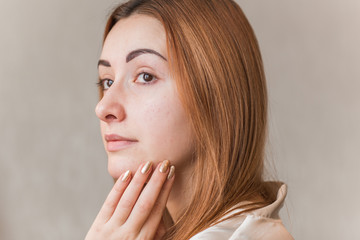Skin Cancer Types, Diagnosis, and Treatment
What is skin cancer?
Skin cancer is an uncontrolled growth of abnormal cells in the skin. It is one of the most common types of cancer. The skin appears to change in texture or color and a sore or nodule may develop on your skin. These skin changes usually can be seen with the naked eye, and 90% can be cured if treated early. The 3 main types of skin cancer are:
Basal cell carcinoma
Squamous cell carcinoma
Melanoma
Basal cell carcinoma accounts for over 75% of all skin cancers. It usually occurs in middle-aged and elderly people, especially those who are fair-skinned. It is more common in people who have regular prolonged sun exposure. Basal cell carcinoma develops slowly and causes a lump or a small, painless, smooth-edged ulcer. It most often occurs on the face, head, or neck. Squamous cell carcinoma also results from too much sun exposure. In addition, pipe and cigar smoking can cause this type of cancer on the lip. It may occur any part of the body that has been exposed to the sun. It starts as a small, usually painless (but sometimes bleeding), irregular skin ulcer that slowly gets bigger. It is common on the lower lip, back of the hands, exposed scalp, cheeks, and ears. Basal cell carcinoma has a very small likelihood of spread to other parts of the body. Squamous cell carcinoma spreads to lymph nodes in advanced cases. Both basal cell carcinoma and squamous cell carcinoma have excellent cure rates when treated promptly. A melanoma usually develops from an existing benign mole. Melanoma is not as common as the other 2 types of skin cancer, but it is more serious and its treatment is different. It is also caused by excessive sun exposure, but it may occur on any skin surface, even places not directly exposed to the sun. For more information on melanoma, see Melanoma.
How does it occur?
The most common and easily preventable cause of skin cancer is exposure to ultraviolet (UV) light from sunlight or tanning beds. Genetic (hereditary) factors play a part in the tendency to develop skin cancer. Some diseases and some chemicals, such as petroleum products, increase your risk of developing skin cancer. Other types of cancer, such as breast or lung cancer, can spread to the skin. These are not skin cancers, however. High-risk professions for skin cancer include farmers, construction workers, other sun-exposed outdoor workers, and vehicle drivers (their sun-exposed arm).
How is it treated?
The treatment for basal cell carcinoma and squamous cell carcinoma is removal of the growth using 1 or more of the following procedures. The choice of treatment depends on the type of cancer and its size and position on the skin. Possible treatments are:
Excision, which is cutting out the affected area and then closing the wound with sutures (stitches)
Mohs surgery (a method of removing and analyzing layers of the growth and surrounding skin)
Scraping off the growth flat with the skin surface, then cauterizing (electrically burning) the area
Using a special medicine (fluorouracil or imiquimod) on tiny cancers and precancerous areas
Radiation therapy.
Some of these methods are useful only in special situations or on one type of cancer. Ask your health care provider for advice about the best treatment for your condition. Excision is the only acceptable method for melanoma. Skin cancer that is untreated or partially treated may result in more severe cancer problems.
How long will the effects last?
The effects will last as long as the cancer cells exist and grow. Unless they are removed, the cancer cells might spread to lymph nodes and internal organs. If you have had skin cancer, you are at a higher risk for developing skin cancer again. Skin cancers may recur in the same location. Your health care provider will want to examine you at 6- to 12-month intervals.
How can I help prevent skin cancer?
Avoid being exposed to too much sunlight. Wear clothing and hats that cover you, and avoid midday sun whenever possible. Use sunscreen lotions to protect against UV light when you must be outdoors. The higher the SPF (sun protection factor), the greater the protection. Use a lotion with an SPF value of at least 15. For water sports, use a sunscreen lotion that resists washing off in the water. If you are allergic to PABA, use PABA-free sunscreen lotions. And remember that UV rays from the sun can penetrate clouds and cause sunburn or damage even on cloudy days. Also, do not use sunlamps or tanning booths. Learn the characteristics of potentially dangerous skin growths, and see your health care provider at the first sign of anything suspicious forming on your skin. If you are at high risk because of previous or ongoing sun exposure, see your provider for a baseline skin exam. If you have a history of sun-related skin changes, such as actinic (solar) keratoses, see your provider regularly on a schedule he or she recommends. To get more information about skin cancer, talk to your provider or contact:
American Cancer Society, Inc.
Phone: 800-ACS-2345 (800-227-2345)
Web site: http://www.cancer.orgAMC Cancer Research Center and Foundation
Phone: 800-525-3777
Web site: http://www.amc.orgCancer Information Service
Phone: 800-4-CANCER (800-422-6237)
Web site: http://cis.nci.nih.gov





